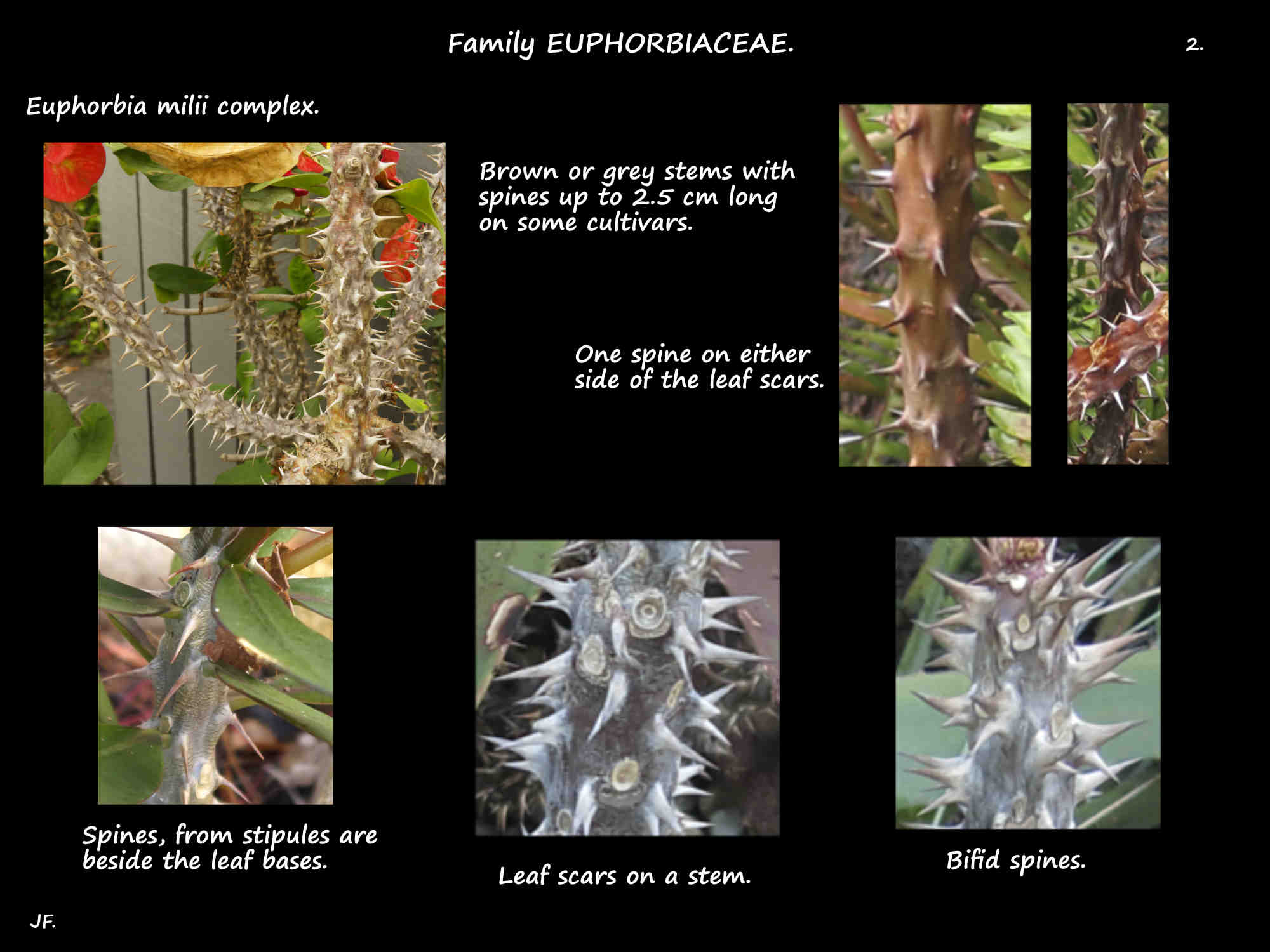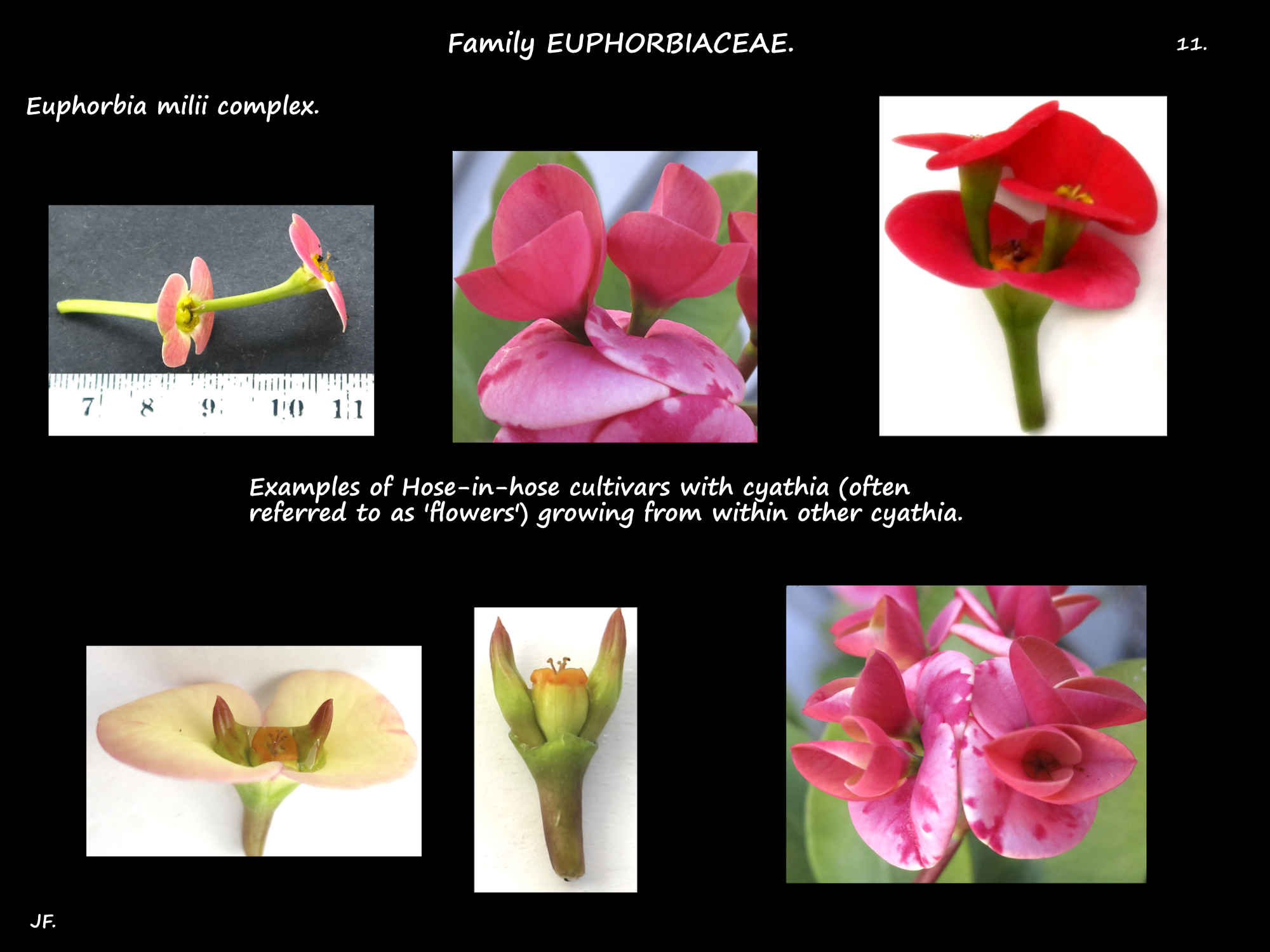Euphorbia milii complex.
Euphorbia milii is from Madagascar although the exact location of the original specimen is uncertain.
The first description in 1826 was overlooked for many years and numerous similar plants, given other
names are now considered to be synonyms or varieties of E. milii.
There are still many uncertainties and the plants are sometimes all grouped together as the E. milii complex.
Today the name E. milii covers any plant from Madagascar that has thorny stems and cymes, on peduncles,
consisting of up to 64 cyathia with large round bracts that are most often red.
The original description includes thorns in horizontal pairs sometimes with a smaller one below,
spatulate leaves with a mucro and pedunculated inflorescences of cyathia with yellow glands.
The ‘Crown of Thorns’ is widely cultivated in gardens.
They are much-branched perennial shrubs with a woody stem up to 1.5 m high.
The brown to greyish stems are slightly angled with up to 6 or 7 sides.
The stems are covered with thick sharp spines 1 to 2 cm long.
Spines, developing from the stipules, can be arranged in spirals or small groups.
Stems and other parts have a milky latex.
Leaves are alternately arranged in a spiral but because of their closeness this may be difficult to see.
If there is a petiole it is very short.
Most have fleshy leaves up to around 5 cm long by 2 cm across.
They are commonly obovate but can be oblong or ovate.
The tip is rounded, sometimes with a mucro, the base wedge-shaped and the edge is smooth.
Older leaves fall off leaving a bare stem with a few leaves at the end.
The axillary inflorescences are a number of cyathia in a cyme on a long peduncle.
Each stalkless cyathium has a cup-shaped involucre of 5 mostly fused bracts up to 4 mm long.
Between the small involucral lobes are 5 kidney-shaped nectiferous glands.
The 1 to 2 mm long glands are yellow to reddish-yellow.
The involucre has 2 coloured bracts at the base that look like petals.
The 15 by 10 mm bracts are round to ovate and as well as shades of red they can be white, pink or yellow.
Inside the involucre are male flowers with no sepals or petals.
The single stamen has an articulated filament on a pedicel that has bracteoles at the base.
The linear bracteoles have a fringed or hairy edge.
Inside the male flowers is a single female flower on a short pedicel.
The superior ovary sometimes has a very narrow rim of perianth below it.
There are 3 bifid styles with their bases fused and 6 bi-lobed stigmas.
The fruit are 3-lobed capsules around 4 mm long with each chamber holding 1 brown seed.
Euphorbia milii hybrids & cultivars.
There are a probably a few hundred hybrids, cultivars and mutants available with many having no registered name.
One species that has been hybridised with E. milii is Euphorbia lophogona.
Cultivars can vary from the species plants in many ways some of which are noted below.
The plants can be mini, dwarf or tall and sparse or compact.
Some have stems with almost no spines while others have larger or softer spines.
The leaf shape and size varies with some being up to 15 cm long.
Green leaves can have greyish veins or be variegated with white, yellow or pink markings.
The number of ‘flowers’ (cyathia) can vary as can their size with some being up to 5 cm across.
Double flowers have more than 2 coloured bracts and hose-in-hose types have flowers growing within flowers (like Azaleas).
Instead of the usual axillary inflorescences there are cultivars with terminal ones.
Single coloured bracts can be white, cream, yellow, salmon, orange and shades of red and pink.
Some flowers have blends of pastel colours and others are speckled or blotched.
The colours may change as the flower matures, for example greenish-yellow bracts with a red centre that
enlarges to cover most of the bract or cream flowers that become pink with red streaks.
J.F.












